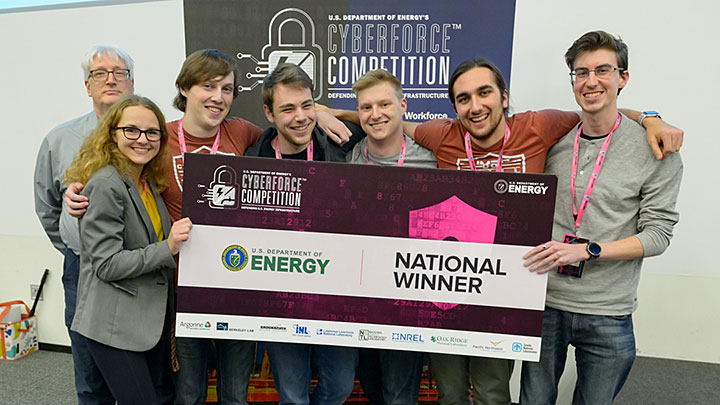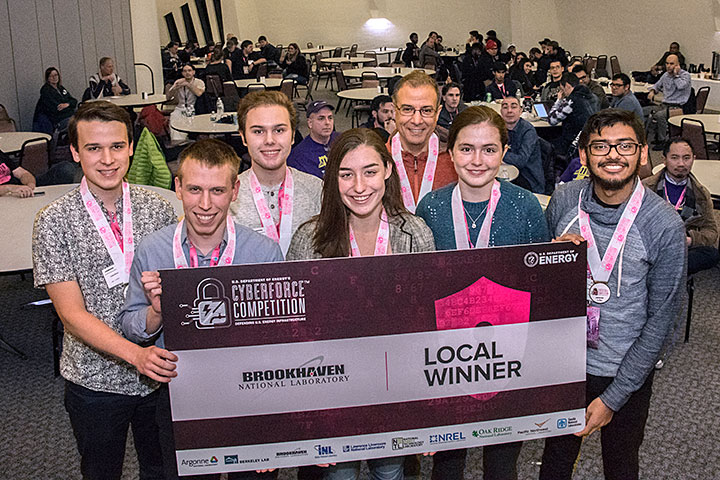University of Maryland, Baltimore County wins 2019 National CyberForce Competition™
November 18, 2019
 enlarge
enlarge
The University of Maryland, Baltimore County (UMBC), is the national winner of the 2019 CyberForce Competition. Brookhaven Lab hosted the UMBC team at last year's competition, where they placed first locally.
The following news release, issued today by the U.S. Department of Energy (DOE), announces the national and local winners of the 2019 CyberForce CompetitionTM. DOE’s Brookhaven National Laboratory was one of 10 DOE national labs that hosted college teams participating in the competition. Of the 105 teams, Brookhaven Lab hosted seven: Columbia University, New York University, Northeastern University, St. John’s University, the State University of New York at Albany, Suffolk County Community College (SCCC), and the U.S. Military Academy (USMA) at West Point. The local winner was Northeastern University.
Today, the U.S. Department of Energy (DOE) announced the team from University of Maryland, Baltimore County as the national winner of DOE’s 2019 CyberForce Competition™. CyberForce 2019 is DOE’s fifth iteration of its cyber defense competition, designed to inspire and develop the next generation of energy sector cybersecurity professionals.
“CyberForce brings together our nation’s brightest students to protect against tomorrow’s threats, a uniquely American approach to problem solving,” said Secretary of Energy Rick Perry. “These competitions identify and honor tomorrow’s cybersecurity experts to encourage their continued work in a vital field. Congratulations to this year’s winners and thank you to all the bright students who participated.”
The competition featured 105 collegiate teams from 32 states and one territory, with participants ranging from undergraduate freshmen to Ph.D. candidates. Argonne National Laboratory was the lead lab with participation from nine other National Labs, including: Brookhaven National Laboratory, Idaho National Laboratory, Lawrence Berkeley National Laboratory, Lawrence Livermore National Laboratory, National Energy Technology Laboratory, National Renewable Energy Laboratory, Oak Ridge National Laboratory, Pacific Northwest National Laboratory, and Sandia National Laboratories.
This year, DOE also hosted a CyberForce Competition Professional Pilot at Argonne National Laboratory to coincide with the collegiate competition, in which a team of experienced cyber defenders tested their cyber prowess in a similar cyber-defense simulation.
This year’s competition challenged teams with not only defending one of four system scenarios—an energy company’s solar generation facility, electric substation, data center, or manufacturing plant—but communicating with the other three infrastructures to monitor and maintain the integrity of the system as a whole. The “adversarial” attacks were executed by experts from the National Labs, the private sector, and the National Guard. Simulated industrial control system components, real-world anomalies and constraints, and interaction with users of the systems added further realism for participating teams.
“Every year, the CyberForce Competition attracts more and more talented students,” said Karen S. Evans, Assistant Secretary for Cybersecurity, Energy Security, and Emergency Response, “and with the expansion to address professional recruitment, the competition will only continue to grow. We envision this competition to be a tool to assist our sector to close skills gaps and shortages of cybersecurity experts.”
Overall nationwide winner:
University of Maryland, Baltimore County | Baltimore, Maryland
Regional winners:
From Argonne National Laboratory:
University of Central Florida | Orlando, Florida
From Brookhaven National Laboratory:
Northeastern University | Boston, Massachusetts
 enlarge
enlarge
Northeastern University was the local winner at Brookhaven Lab. From left to right: Kyle Sferrazza, Matthew Kline, Simon Bruklich, Brianna Weinstein, Guevara Noubir (professor), Fiona McCrae, and Anuj Modi.
From Idaho National Laboratory:
University of Idaho, Idaho Falls | Idaho Falls, Idaho
From Lawrence Berkeley National Laboratory:
University of California, Davis | Davis, California
From Lawrence Livermore National Laboratory:
California State University, Sacramento | Sacramento, California
From National Energy Technology Laboratory:
Baldwin Wallace University | Berea, Ohio
From National Renewable Energy Laboratory:
University of Colorado, Boulder | Boulder, Colorado
From Oak Ridge National Laboratory:
University of Florida | Gainesville, Florida
From Pacific Northwest National Laboratory:
Oregon State University | Corvallis, Oregon
From Sandia National Laboratories:
Southern Methodist University | Dallas, Texas
More information on DOE’s CyberForce Competition can be found HERE.
Brookhaven National Laboratory is supported by the U.S. Department of Energy’s Office of Science. The Office of Science is the single largest supporter of basic research in the physical sciences in the United States and is working to address some of the most pressing challenges of our time. For more information, visit https://energy.gov/science.
Follow @BrookhavenLab on Twitter or find us on Facebook.
2019-16839 | INT/EXT | Newsroom









